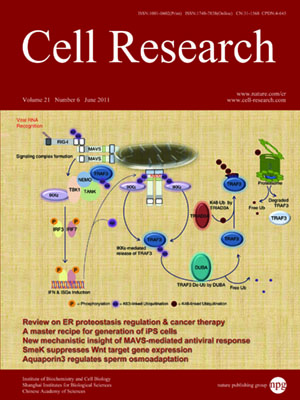Volume 21 Issue 6, June 2011: 895-910
ORIGINAL ARTICLES
A functional C-terminal TRAF3-binding site in MAVS participates in positive and negative regulation of the IFN antiviral response
Suzanne Paz1,2, Myriam Vilasco3, Steven J Werden1, Meztli Arguello1, Deshanthe Joseph-Pillai1,2, Tiejun Zhao1, Thi Lien-Anh Nguyen1, Qiang Sun1, Eliane F Meurs3, Rongtuan Lin1,4 and John Hiscott1,2,4
1Terry Fox Molecular Oncology Group, Lady Davis Institute, Jewish General Hospital, Montreal, Quebec H3T1E2, Canada
2Department of Microbiology and Immunology, McGill University Montreal, Quebec H3A 2B4, Canada
3Department of Virology, Unit of Hepacivirus and Innate Immunity, Pasteur Institute, Paris 75724 France
4Department of Medicine, McGill University Montreal, Quebec H3A 2B4, Canada
Correspondence: John Hiscott,(john.hiscott@mcgill.ca)
Recognition of viral RNA structures by the cytosolic sensor retinoic acid-inducible gene-I (
RIG-I) results in the activation of signaling cascades that culminate with the generation of the type I interferon (IFN) antiviral response. Onset of antiviral and inflammatory responses to viral pathogens necessitates the regulated spatiotemporal recruitment of signaling adapters, kinases and transcriptional proteins to the mitochondrial antiviral signaling protein (MAVS). We previously demonstrated that the serine/threonine kinase IKK
ε is recruited to the C-terminal region of MAVS following Sendai or vesicular stomatitis virus (VSV) infection, mediated by Lys63-linked polyubiquitination of MAVS at Lys500, resulting in inhibition of downstream IFN signaling (
Paz et al, Mol Cell Biol, 2009). In this study, we demonstrate that C-terminus of MAVS harbors a novel TRAF3-binding site in the aa450-468 region of MAVS. A consensus TRAF-interacting motif (TIM), 455-PEENEY-460, within this site is required for TRAF3 binding and activation of IFN antiviral response genes, whereas mutation of the TIM eliminates TRAF3 binding and the downstream
IFN response. Reconstitution of MAVS
−/− mouse embryo fibroblasts with a construct expressing a TIM-mutated version of MAVS failed to restore the antiviral response or block VSV replication, whereas wild-type MAVS reconstituted antiviral inhibition of VSV replication. Furthermore, recruitment of IKK
ε to an adjacent C-terminal site (aa 468–540) in MAVS via Lys500 ubiquitination decreased TRAF3 binding and protein stability, thus contributing to IKK
ε-mediated shutdown of the IFN response. This study demonstrates that MAVS harbors a functional C-terminal TRAF3-binding site that participates in positive and negative regulation of the IFN antiviral response.
Cell Research (2011) 21:895-910. doi:10.1038/cr.2011.2; published online 4 January 2011
FULL TEXT | PDF
Browse 2181


